Data Center Cooling Market Size
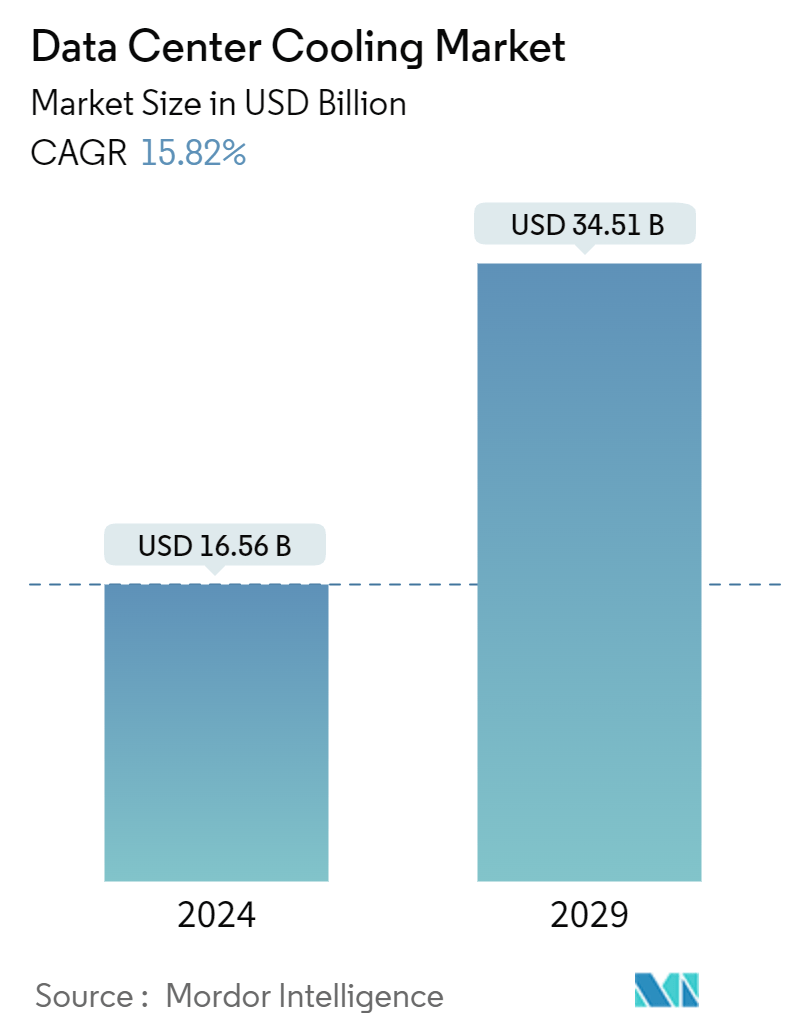
| Study Period | 2019 - 2029 |
| Market Size (2024) | USD 16.56 Billion |
| Market Size (2029) | USD 34.51 Billion |
| CAGR (2024 - 2029) | 15.82 % |
| Fastest Growing Market | Asia Pacific |
| Largest Market | North America |
Major Players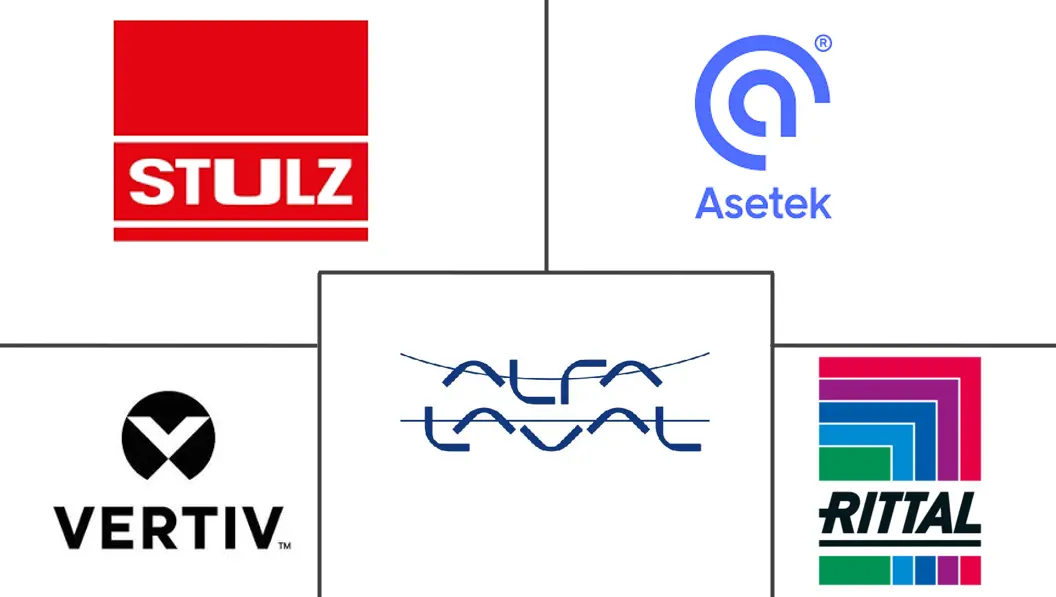
*Disclaimer: Major Players sorted in no particular order |
Data Center Cooling Market Analysis
The Data Center Cooling Market size is estimated at USD 16.56 billion in 2024, and is expected to reach USD 34.51 billion by 2029, growing at a CAGR of 15.82% during the forecast period (2024-2029).
Due to the high computational needs of AI and media applications, data centers are being increasingly deployed worldwide. These data centers consume a massive amount of power, generating a significant amount of heat, further creating the need for various efficient cooling systems.
- The data center cooling market is expected to show substantial growth due to the increase in digitization worldwide, which will lead to greater computer performance and require a larger number of integrated small chips. The design of data centers and the need to cool them are mainly influenced by powerful computer hardware for AI workloads. Manufacturers are introducing large silicon chips to optimize the performance of artificial intelligence and high-performance computing workloads. The use of powerful GPUs in artificial intelligence and high-performance computing environments supports the need for data center cooling technologies.
- The increasing use of OTT and streaming services has led to a growth in data, fostering market development. Also, the increasing data from online streaming services such as Disney+ Hotstar, Hulu, and Netflix is expected to drive the demand for data center cooling systems.
- Market players are taking action to augment their consumer base by focusing on expanding their global footprint and service offerings. For instance, in March 2024, the intelligent power management company Eaton declared the North American launch of an innovative new modular data center solution for organizations that are seeking to rapidly fulfill the increasing requirements for machine learning, edge computing, and AI. Eaton's SmartRack modular data centers primarily combine IT racks, cooling, and service enclosures to build a performance-optimized data center solution for critical IT equipment with up to 150 kW of equipment load.
- The market's growth is expected to be hampered by the rising need for various adaptability requirements and power shortages worldwide. Also, factors like the use of inefficient cooling system designs, such as outdated infrastructure or poorly optimized layouts, leading to energy inefficiencies and increased operational costs, and rising energy prices, which might make the cooling expenses prohibitive, are some of the factors that can restrain the market growth during the forecast period.
- The COVID-19 pandemic negatively influenced a cooling market for data centers. However, in the post-COVID-19 period, the use of cloud services increased significantly, leading to the generation of massive amounts of data. This, in turn, is expected to drive the market's growth opportunities.
Data Center Cooling Market Trends
The Information Technology Segment is Expected to Witness the Highest Growth
- The exponential growth of data generated by information technology significantly necessitates efficient data centers, driving demand for advanced cooling solutions. As data centers expand to accommodate increasing workloads and storage demands, the heat generated becomes a significant matter of concern, creating a demand for effective cooling solutions.
- Innovative cooling technologies, like liquid cooling systems and airflow optimization techniques, are essential to maintaining optimal operating conditions. This surge in demand for data center cooling solutions is propelling the market's growth, with businesses investing in solutions like energy-efficient and sustainable cooling to mitigate costs and environmental impact while ensuring the uninterrupted performance of their overall IT infrastructure.
- The adoption of cloud storage has been increasing over the years. To provide more efficient work processes, cloud storage providers such as Microsoft, AWS, and Google are expanding their capacity to store in the cloud. These companies make their investments in hyperscale transactions. As a result, the demand for data center cooling systems is expected to grow due to the growth of Software-as-a-Service, enabling cloud storage providers to expand their capacity.
- Despite the rapid development of cloud services, there is considerable reliance on on-promise and hybrid data centers in the current market scenario. Also, the need for efficient data storage solutions is increasing due to the trend toward agile and DevOps operating frameworks in the IT sector.
- As of March 2024, there were 5,381 data centers in the United States, the highest worldwide. Around 521 were located in Germany, while 514 were located in the United Kingdom. Hence, with the rise in the number of data centers, the market is expected to witness significant growth throughout the forecast period.
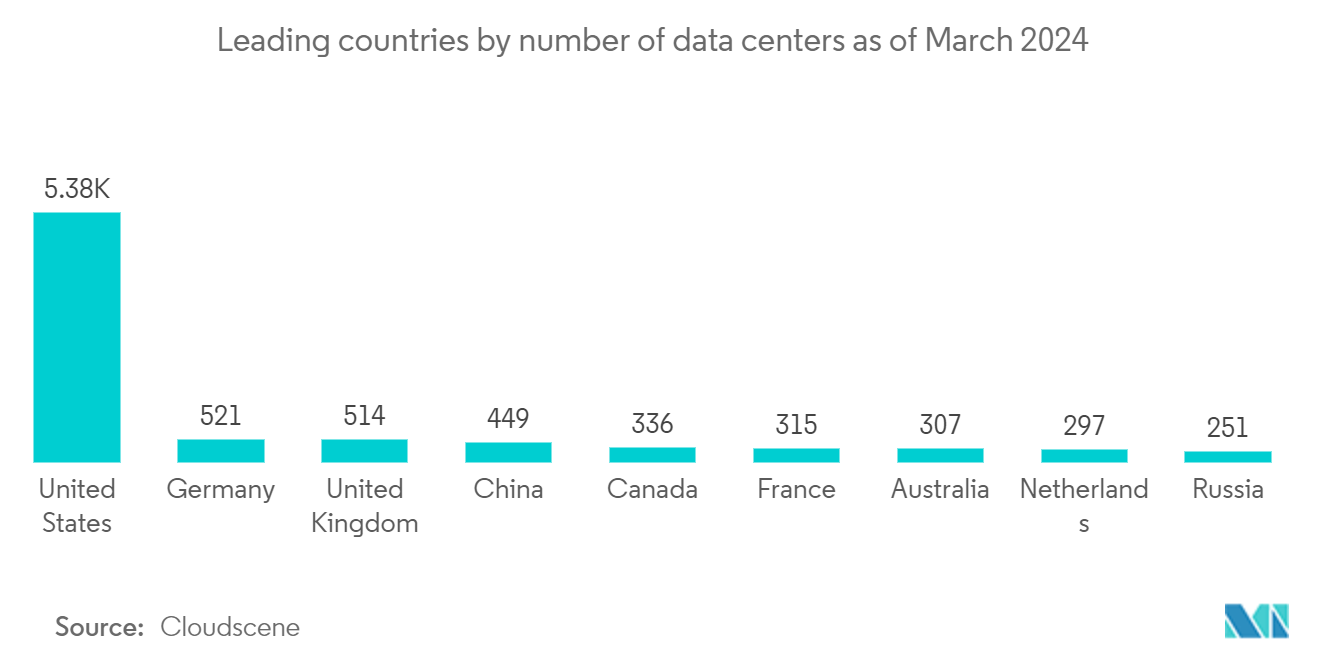
The Asia-Pacific Region is Expected to Register Significant Growth
- The APAC region is estimated to witness the fastest growth rate during the forecast period, mainly due to the rapid development of the network infrastructure. The demand for data generation is increasing in the region, and government policies are promoting more energy-efficient infrastructure, especially in countries like India and China. Also, advancements in technologies such as AI-driven cooling management and liquid cooling systems are reshaping the landscape, driving further adoption in the region.
- China and Japan are among the most important countries that are expected to fuel the market's growth opportunities significantly based on their ongoing recent innovations and developments in domains like IoT, ML, and AI. Moreover, the rapidly growing number of data centers in these countries, along with the government policies to promote more environmentally sound infrastructure across the region, is driving the need for better and more effective cooling solutions within these data centers.
- For instance, in April 2024, GDS, an operator and developer of high-performance data centers in Asia, and Gaw Capital Partners, a private equity fund management firm especially focusing on the real estate markets in the Asia Pacific and other high barrier-to-entry markets worldwide, signed a strategic partnership to build a 40 megawatts (MW) data center campus in Tokyo, Japan.
- The Asia Pacific region's data center cooling solutions market is primarily fueled by the exponential growth of data consumption and cloud services. As businesses expand their digital infrastructure, the demand for efficient cooling systems to maintain optimal operating temperatures increases. Additionally, stringent regulations regarding energy efficiency and environmental sustainability encourage the adoption of innovative cooling technologies. With emerging economies investing heavily in IT infrastructure, the need for reliable and scalable cooling solutions further fuels market growth.
- In December 2023, the Australian cloud service provider ResetData launched a test and simulation lab for its pioneering liquid-cooled data center server technology. This was one of the first facilities in the Asia-Pacific region capable of trialing workloads in a liquid-cooled environment. This step empowered local businesses to utilize a more ecologically friendly and high-performance Infrastructure-as-a-Service (IaaS) that is essential for strenuous applications like AI and machine learning.
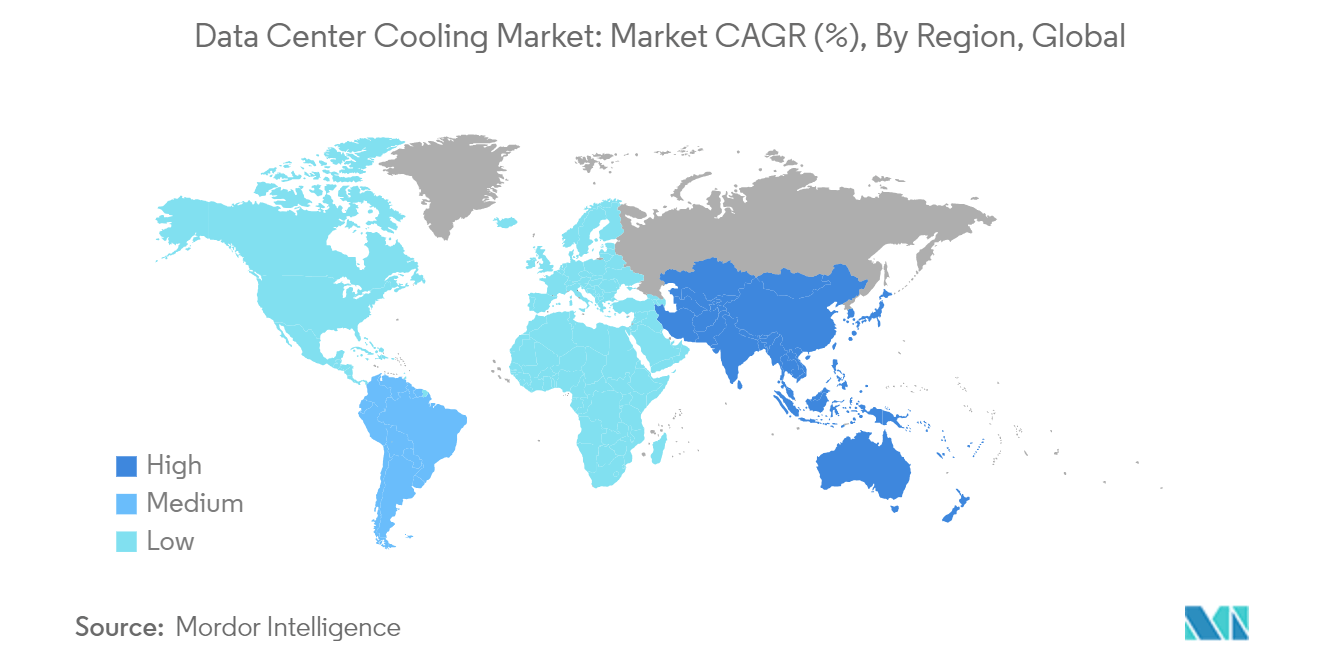
Data Center Cooling Industry Overview
The data center cooling market is fragmented in nature, with the presence of several major players. With the increasing focus on innovation, the demand for new technologies is growing, which, in turn, is driving investments for further developments. Key players in the market include Daikin Industries Ltd, Schneider Electric SE, and Mitsubishi Electric Corporation.
- March 2024: Boreas Technology, a specialist in data center cooling technologies, developed the Rear Door Cooling Device, which is designed for high-density environments. This innovation provides precision cooling with up to 50 kW capacity. Efficiency, sustainability, and industry-leading standards are offered with the rear door cooling device. This also allows efficient operation for cabinets expected to operate at high capacity and density in data centers, enabling effective heat management.
- January 2024: Modine, a diversified global provider of innovative thermal management solutions, purchased the intellectual property and other specific assets of TMG Core, a specialist in single- and two-phase liquid immersion cooling technology for data centers with high-density computing requirements.
Data Center Cooling Market Leaders
-
Stulz GmbH
-
Rittal GmbH & Co. KG
-
Vertiv Group Corp.
-
Asetek A/S
-
Alfa Laval AB
*Disclaimer: Major Players sorted in no particular order
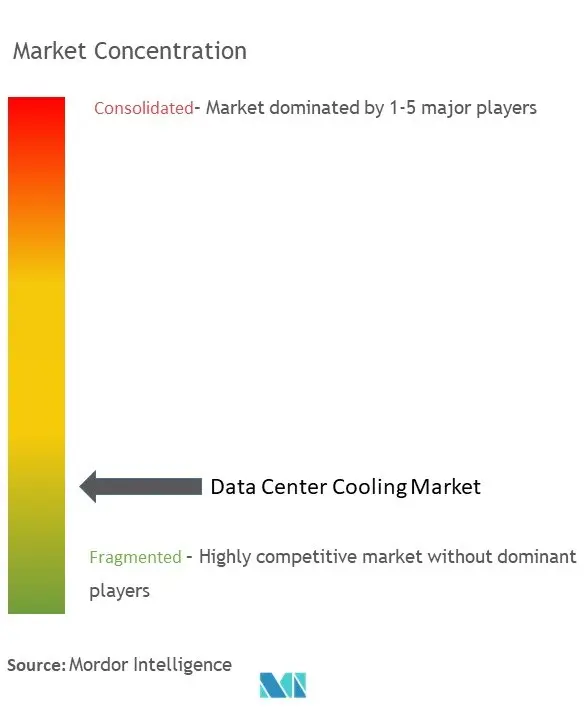
Data Center Cooling Market News
- January 2024: Aligned Data Centers, the technology infrastructure company providing sustainable, innovative, and adaptive scale data centers and build-to-scale solutions for global hyperscale and enterprise customers, introduced its DeltaFlow liquid cooling technology. DeltaFlow is a patent-pending solution built to support the high-density computing requirements of next-generation applications and high-performance computing, including artificial intelligence, machine learning, and supercomputers. DeltaFlow extends Aligned's ExpandOnDemand capabilities, providing customers the flexibility to seamlessly scale and pivot to support shifting computing environments.
- November 2023: Vertiv, a worldwide provider of critical digital infrastructure and continuity solutions, introduced a prefabricated modular data center, Vertiv SmartMod Max CW. It was built to address the increasing demand for rapid deployment of computing. This configurable and scalable solution supports up to 200 kW of total IT load in a single system and utilizes chilled water cooling for reduced environmental impact and energy efficiency.
Data Center Cooling Market Report - Table of Contents
1. INTRODUCTION
- 1.1 Study Assumptions and Market Definition
- 1.2 Scope of the Study
2. RESEARCH METHODOLOGY
3. EXECUTIVE SUMMARY
4. MARKET INSIGHTS
- 4.1 Market Overview (Coverage: A detailed analysis of the current global trends related to Data Center Cooling are included in this section)
-
4.2 Key cost considerations for Cooling
- 4.2.1 Analysis of the key cost overheads related to DC operations with an eye on DC Cooling
- 4.2.2 Key innovations and developments in Data Center Cooling
- 4.2.3 Key energy efficiency practices adopted in Data Centers
5. MARKET DYNAMICS
- 5.1 Market Drivers (Key factors such as the increased emphasis on energy consumption, move towards green solutions are mapped based on their relative impact over the next 5-7 years)
- 5.2 Market Challenges (Key factors such as the dynamic nature of regulations, evolving customer needs are mapped based on their relative impact over the next 5-7 years)
- 5.3 Market Opportunities
- 5.4 Comparison of raised floor with containment & raised floor without commitment
- 5.5 Industry Ecosystem Analysis
6. ANALYSIS OF THE CURRENT GLOBAL DATA CENTER FOOTPRINT
- 6.1 Regional Analysis of IT Load Capacity & Area Footprint of Data Centers (for the period of 2017-2030)
- 6.2 Regional Analysis of the Established (Ex: FLAP-D) DC Markets and Emerging DC Hotspots in APAC region (we will include coverage by highlighting major established and emerging DC markets)
- 6.3 Regional Analysis of Regulatory Framework On DC Cooling
7. GLOBAL DATA CENTER COOLING MARKET SEGMENTATION
-
7.1 By Cooling Technology (Key trends, market size estimates & projections for the period of 2022-2029 and future outlook)
- 7.1.1 Air-based Cooling
- 7.1.1.1 CRAH
- 7.1.1.2 Chiller and Economizer
- 7.1.1.3 Cooling Tower (covers direct, indirect & two-stage cooling)
- 7.1.1.4 Others
- 7.1.2 Liquid-based Cooling
- 7.1.2.1 Immersion Cooling
- 7.1.2.2 Direct-to-Chip Cooling
- 7.1.2.3 Rear-Door Heat Exchanger
-
7.2 By End-user Vertical
- 7.2.1 IT & Telecom
- 7.2.2 Retail & Consumer Goods
- 7.2.3 Healthcare
- 7.2.4 Media & Entertainment
- 7.2.5 Federal & Institutional agencies
- 7.2.6 Other End-users Verticals
-
7.3 By Geography
- 7.3.1 North America
- 7.3.2 Europe
- 7.3.3 Asia
- 7.3.4 Australia and New Zealand
- 7.3.5 South America
- 7.3.6 Middle East
- 7.3.7 Africa
8. COMPETITIVE LANDSCAPE
-
8.1 Company Profiles
- 8.1.1 Stulz GmbH
- 8.1.2 Rittal GmbH & Co. KG
- 8.1.3 Vertiv Group Corp.
- 8.1.4 Asetek A/S
- 8.1.5 Alfa Laval AB
- 8.1.6 Schneider Electric SE
- 8.1.7 Iceotope Technologies Limited
- 8.1.8 Green Revolution Cooling Inc.
- 8.1.9 Chilldyne Inc.
- 8.1.10 Airedale International Air Conditioning Ltd
- *List Not Exhaustive
9. INVESTMENT ANALYSIS
10. MARKET OPPORTUNITIES AND FUTURE TRENDS
** Subject To AvailablityData Center Cooling Industry Segmentation
Data center cooling refers to the collective equipment, tools, techniques, and processes that ensure an ideal operating temperature within a data center facility. With increasing capacity and higher density, there is an increasing need for energy-efficient cooling of IT equipment. Furthermore, benefits offered by the technology and support from the government by imposing efficiency regulations on data centers are expected to boost the growth of the data center cooling market directly in various fields such as IT, BFSI, Telecommunication, etc.
The global data center cooling market is segmented by cooling technology (air-based cooling (CRAH, chiller and economizer, cooling tower (direct, indirect, and two-stage cooling), and others)) and liquid-based cooling (immersion cooling, direct-to-chip cooling, and rear-door heat exchanger)), end-user vertical (IT & telecom, retail & consumer goods, healthcare, media & entertainment, federal & institutional agencies, and other end users), and by geography (North America, Europe, Australia and New Zealand, South America, and the Middle East and Africa) The market sizes and forecasts are provided in terms of value (USD) for all the above segments.
| By Cooling Technology (Key trends, market size estimates & projections for the period of 2022-2029 and future outlook) | Air-based Cooling | CRAH |
| Chiller and Economizer | ||
| Cooling Tower (covers direct, indirect & two-stage cooling) | ||
| Others | ||
| By Cooling Technology (Key trends, market size estimates & projections for the period of 2022-2029 and future outlook) | Liquid-based Cooling | Immersion Cooling |
| Direct-to-Chip Cooling | ||
| Rear-Door Heat Exchanger | ||
| By End-user Vertical | IT & Telecom | |
| Retail & Consumer Goods | ||
| Healthcare | ||
| Media & Entertainment | ||
| Federal & Institutional agencies | ||
| Other End-users Verticals | ||
| By Geography | North America | |
| Europe | ||
| Asia | ||
| Australia and New Zealand | ||
| South America | ||
| Middle East | ||
| Africa |
Data Center Cooling Market Research FAQs
How big is the Data Center Cooling Market?
The Data Center Cooling Market size is expected to reach USD 16.56 billion in 2024 and grow at a CAGR of 15.82% to reach USD 34.51 billion by 2029.
What is the current Data Center Cooling Market size?
In 2024, the Data Center Cooling Market size is expected to reach USD 16.56 billion.
Who are the key players in Data Center Cooling Market?
Stulz GmbH, Rittal GmbH & Co. KG, Vertiv Group Corp., Asetek A/S and Alfa Laval AB are the major companies operating in the Data Center Cooling Market.
Which is the fastest growing region in Data Center Cooling Market?
Asia Pacific is estimated to grow at the highest CAGR over the forecast period (2024-2029).
Which region has the biggest share in Data Center Cooling Market?
In 2024, the North America accounts for the largest market share in Data Center Cooling Market.
What years does this Data Center Cooling Market cover, and what was the market size in 2023?
In 2023, the Data Center Cooling Market size was estimated at USD 13.94 billion. The report covers the Data Center Cooling Market historical market size for years: 2019, 2020, 2021, 2022 and 2023. The report also forecasts the Data Center Cooling Market size for years: 2024, 2025, 2026, 2027, 2028 and 2029.
What are the key factors driving the Data Center Cooling Market?
Major factors driving the Data Center Cooling Market include a) Rising amount of data generated by industries b) Increasing adoption of cloud services c) Need for energy-efficient cooling solutions
Data Center Cooling Industry Report
The Global Data Center Cooling Market Report is segmented by solution, service, end-user vertical, and geography. The market sizes and forecasts are provided in terms of value for all the segments. The data center cooling market is poised for substantial growth, driven by the increasing demand for efficient cooling solutions to manage the heat from high-density computing in various industries. This surge is fueled by the expansion in data generation, cloud computing, and IoT applications.
Innovations in the sector, such as modular and scalable cooling systems like row/rack-based cooling, are crucial for adapting to the evolving needs of data centers. The Asia Pacific region, in particular, is expected to witness the highest growth due to rapid digital transformation and significant IT infrastructure investments. Key segments like mid-sized data centers and academic sectors are also projected to see notable expansion, highlighting the importance of advanced cooling technologies in promoting sustainable and energy-efficient operations.
According to Mordor Intelligence™ industry reports, the data center cooling solutions market trends indicate a robust expansion. For detailed insights on data center cooling market size and trends, download a free PDF sample of the industry analysis from Mordor Intelligence™. The market forecast shows a promising market growth, driven by the increasing market size and market share. The market analysis reveals a comprehensive market overview, with significant market trends shaping the global market outlook.
The market review highlights the importance of market segmentation in understanding market value and market predictions. Industry information points to a strong growth rate, supported by thorough industry research and industry sales data. The industry statistics provide a clear industry outlook, emphasizing the role of market leaders in driving the market forward. Research companies are focusing on delivering accurate market data and market predictions to help stakeholders make informed decisions.
The report example and report PDF offer valuable insights into the market trends and market segmentation, ensuring that the industry remains well-informed and prepared for future developments.



